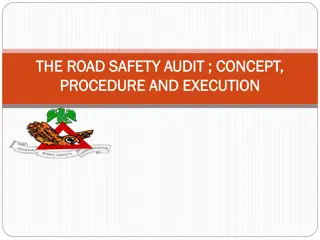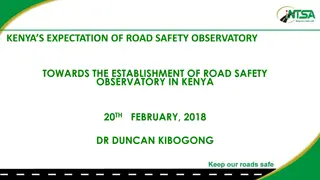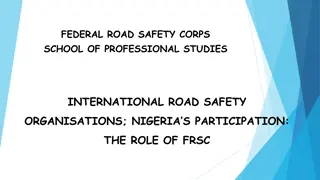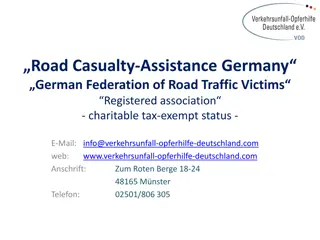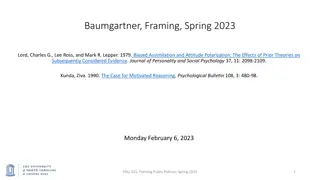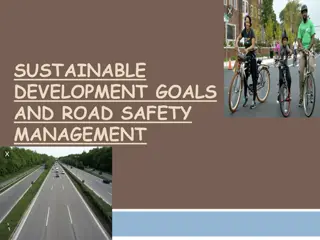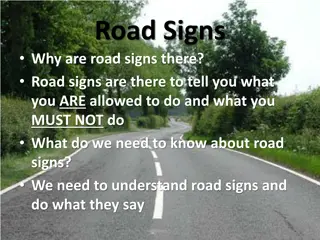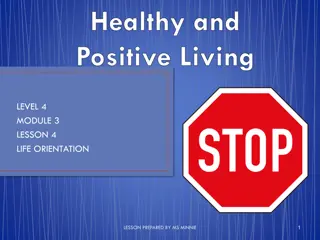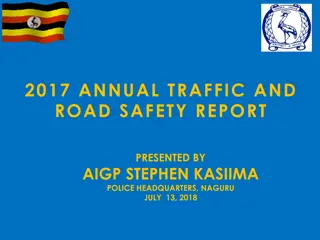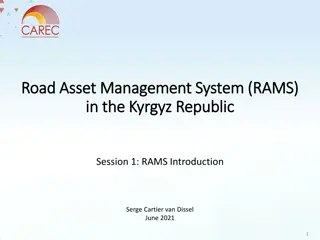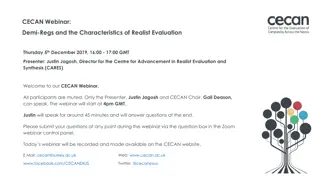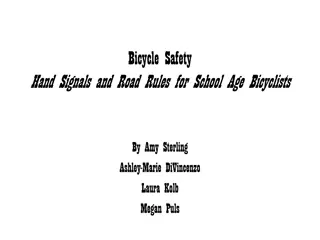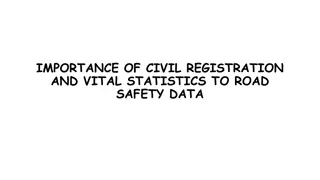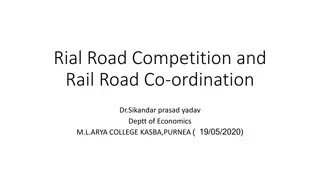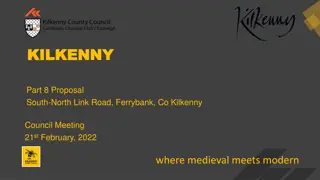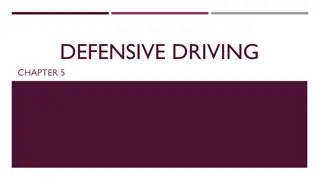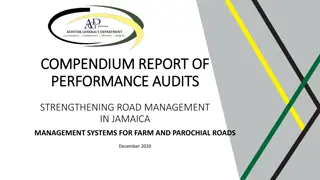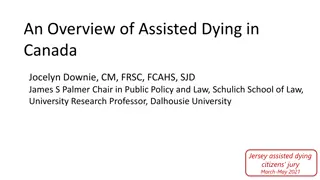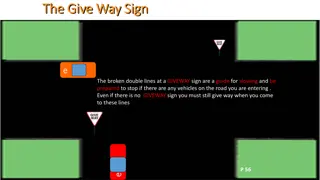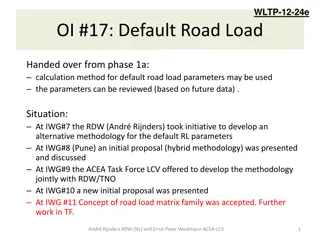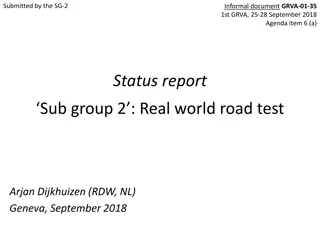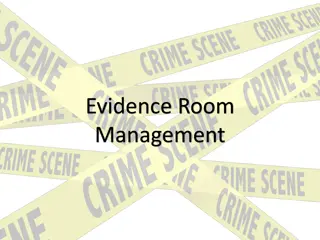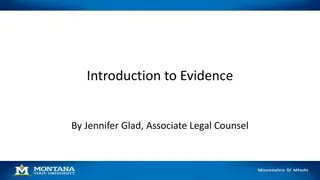Evaluation of Evidence for Road Safety Policies in Canada
The study critically appraises the evidence underlying road safety policies in urban municipalities of Canada. Data was collected through an environmental scan in five cities, identifying various interventions in road safety policies. A total of 383 studies were analyzed across different categories related to built environment interventions. The study aims to determine the level of evidence supporting these interventions and their impact on road safety.
Download Presentation

Please find below an Image/Link to download the presentation.
The content on the website is provided AS IS for your information and personal use only. It may not be sold, licensed, or shared on other websites without obtaining consent from the author. Download presentation by click this link. If you encounter any issues during the download, it is possible that the publisher has removed the file from their server.
E N D
Presentation Transcript
How good is the evidence underlying road safety policies in Canada? Sarah A. Richmond1,2, Tona Pitt3, Tanita Siladi4, Liraz Fridman5, Pamela Fuselli6, Ian Pike7,8, Claire Buchan1,4, Alison Macpherson4 1Public Health Ontario, Toronto; 2University of Toronto, Toronto; 3University of Calgary, Calgary; 4York University, Toronto; 5Hospital for Sick Children, Toronto; 6Parachute, Toronto; 7University of British Columbia, British Columbia; 8 BC Injury Research and Prevention Unit, BC Children s Hospital Research Institute
Background: Road Safety Poses a significant public health problem Requires a pubic health approach Making decisions on interventions - including policies that are based in evidence
Background: Road Safety Breadth of literature across road users Variability in effectiveness across interventions
Research Objective: Critically appraise and determine the level of evidence of Critically appraise and determine the level of evidence of built environment studies from road safety policies in built environment studies from road safety policies in urban municipalities urban municipalities
Methods: Data Collection Environmental scan across 5 urban municipalities in Canada was completed to determine the types of interventions in road safety policies Toronto, Peel, Calgary, Vancouver, Montreal Articles were retrieved from citations within the policies themselves, literature search, reference to a recently completed (not yet published) systematic review
Methods: Data Collection There were 383 studies grouped into 6 categories - Streets and sidewalks, bicycle related, intersections & crossings, traffic calming, school zones, address > one Inclusion Inclusion: examined BE intervention, injury or injury pathway outcome, all study designs Exclusion Exclusion: non-BE interventions, implementation/planning guides, modal choice, increasing physical activity
Methods: Data Analysis Used guidance from an evidence synthesis framework1 to critically appraise and determine level of evidence2 of each study Critical Appraisal: an appropriate tool was selected for each study to evaluate internal and external validity Level of Evidence: adaptation of tools from the Canadian Guide to Clinical Preventative Health Care and the Community Guide2 1Chambers and Richmond et al., (2014) J Public Health;1-7; 2Briss et al. (2000). Developing an evidence-based guide to community preventive services-methods. Am J Prev Med;18(1S).
Methods:Critical Appraisal Tools AXIS: AXIS: Cross-sectional studies1 CASP CASP: Case-control studies2 CASP CASP: Cohort studies2 TREND TREND: Quasi-experimental studies3 HEALTH EVIDENCE HEALTH EVIDENCE: Reviews (including systematic)4 1Downes et al. (2016). Development of a critical appraisal tool to assess the quality of cross-sectional studies (AXIS). BMJ Open; 6:e011458; 2Public Health Resource Unit (2006). The Critical Skills Appraisal Programme: making sense of evidence. Public Health Resource Unit, England. Retrieved from: http://www.casp-uk.net/; 3Des Jarlais DC, Lyles C, Crepaz N, and the TREND Group. Improving the reporting quality of nonrandomized evaluations of behavioral and public health interventions: The TREND statement. Am J Public Health. 2004;94:361-366; Health Evidence. (2013). Quality assessment tool. McMaster University. Retrieved from: http://www.healthevidence.org/documents/our-appraisaltools/QA_tool&dictionary_18.Mar.2013.pdf
Methods: Categorization of Quality For each tool, total scores were divided into three equivalent categories weak, weak, moderate, moderate, strong strong AXIS [0-20] CASP CC [0-11] CASP C [0-14] TREND [0-22] HE [0-10] 0-6: Weak 0-3: Weak 0-4 Weak 0-7 Weak 0-4: Weak 7-13: Moderate 4-7: Moderate 5-9: Moderate 8-15: Moderate 5-7: Moderate 14-20: Strong 8-11: Strong 10-14: Strong 16-22: Strong 8-10: Strong
Methods: Levels of Evidence Results from both the critical appraisal (weak, moderate, strong strong) and the study results were used to determine the level of evidence for each study weak, moderate, Sufficient / Insufficient
Methods: Levels of Evidence A. Mostly the presence of association, or positive outcomes, additional studies are unlikely to change the direction of effect Some evidence of association or positive outcomes; hesitant in a strong statement about association or recommendation, need for high quality studies (promising) Mixed results, few or poor studies, better studies are needed D. Absence of association or positive impact across the majority of studies; improved studies could change the conclusion E. Absence of association or positive impact across studies and improved studies would unlikely change their conclusion B. C.
Methods: Levels of Evidence A. Mostly the presence of association, or positive outcomes, additional studies are unlikely to change the direction of effect Some evidence of association or positive outcomes; hesitant in a strong statement about association or recommendation, need for high quality studies (promising) B. SUFFICIENT EVIDENCE
Methods: Levels of Evidence INSUFFICIENT EVIDENCE C. D. Absence of association or positive impact across the majority of studies; improved studies could change the conclusion E. Absence of association or positive impact across studies and improved studies would unlikely change their conclusion Mixed results, few or poor studies, better studies are needed
Results:Overall A total of 68 studies 68 studies (of 383 total interventions) were included (1983 (1983 2019) 2019) 40 quasi experimental studies, 12 cross sectional studies, 7 case control studies, 1 cohort study, and 8 reviews Strong Quality: 24 Moderate Quality: 39 Weak Quality: 5 5 24 39
Results: Streets and Sidewalks Sufficient levels of evidence: Street trees (speed) Streetcar right of way (collisions) Mixed (both sufficient and insufficient): Lane width Insufficient evidence: Street lighting (collisions) Pedestrian refuge islands/plazas (collisions) Pedestrian overpass (injuries) Road diets (collisions) 10 studies 2002-2018 n= 4 cross sectional n= 6 quasi- experimental 5 strong 4 moderate 1 weak Levels of evidence: sufficient=3 (a=2; b=1); insufficient=7 (c=0; d=4, e=3)
Results: Bicycle Related Sufficient levels of evidence: Bike sidewalks (collisions) Minor streets, diverters, lower speeds, quieter streets (injury) Mixed (both sufficient and insufficient): 14 studies 1998-2019 n= 4 case control Cycle tracks Bike boxes Bike lanes Increased risk (insufficient evidence): Roundabouts n= 2 cross sectional n= 5 quasi- experimental n= 3 reviews 8 strong 6 moderate Levels of evidence: sufficient=7 (a=6; b=1); insufficient=7 (c=3; d=4)
Results: Intersections and Crossings Sufficient levels of evidence: Smart channels (conflicts) Advanced stop lines (% drivers stopped) Raised medians, sidewalks (speed) High intensity activated crossing (collisions) Mixed (sufficient and insufficient evidence): Advanced yield markings (conflicts, collisions) Pedestrian signal crossing (collisions, and yielding behavior) Zebra crossing/pavement markings (injury severity, collisions, conflicts) Yield signs (conflicts, yielding) Pedestrian countdown signals (collisions) *n= 4 reports without a published date 22 studies 2004-2017* n= 3 case control n= 2 cross sectional n= 16 quasi- experimental n= 1 cohort 2 weak 7 strong 13 moderate Levels of evidence: sufficient=13 (a=3; b=10); insufficient=9 (c=2; d=3, e=4)
Results: Traffic Calming *n= 3 reports without a published date 17 studies 1983-2016* n=11 quasi- experimental n=3 cross sectional n=3 reviews 13 moderate 3 strong 1 weak Levels of evidence: sufficient= 9 (a=1; b=8); insufficient= 8 (c=2; d=4, e=2)
Results: Traffic Calming Designated crossings with median (n=1), roundabouts, road diets, vertical deflections, horizontal deflections or narrowings, speed cameras (n=1), 12 ft humps, 14 ft humps, 22 ft tables, circles, narrowings, one lane slow points, full closures, half closures, diagonal diverters, other (n=1), road lighting (n=1), one review included all studies that measures some form of calming - redirecting traffic, speed reducing does not specify the exact calming measures used (n=1), chokers, raised intersections, refuge islands (n=1), zebra crossings with and without other countermeasures curb extensions, parking restrictions, advanced yield options driver simulations (n=1), speed reduction (20 mph) (n=1), speed (speed gun) (n=1), pinch points (n=1), chicanes (n=1), traffic calming measures (n=1), speed reductions with speed bumps, central islands, narrowing) (n=1), sign deterrents (n=1), road humps (n=1), traffic calming (humps, circles, closures, narrowings) (n=1), rapid beacons triggered by excessive speed (n=1)
Results: School Zones 1 study 2016 Insufficient evidence: (volume, speed) Flashing beacon School crossing ahead warning Reduce speed and school crossing warning School crossing ahead pavement markings n=1 quasi- experimental 1 moderate Levels of evidence: insufficient=1; (c=1)
Results: Addresses > One Sufficient evidence: (One study, 13 interventions - collisions): Intersections Segments 4 studies 2003-2012 All pedestrian phase Bike lanes High visibility crosswalk Bus lanes n=1 quasi- experimental n=1 cross sectional Pedestrian crossing time Pedestrian fencing n=2 reviews Left turn bay Road diet Left turn phase Speed humps Pedestrian signals Speed limits 2 moderate 1 strong 1 weak Split phase timing Levels of evidence: sufficient=1 (a=1); insufficient=3; (c=2, d=1)
Discussion: Impact There is a breadth of road safety policies implemented at a municipal level The quality of evidence associated with these interventions varies based on internal and external validity Important to highlight the variability in effectiveness of interventions when making decisions for population level impact
Discussion: Strengths/Limitations First study to examine the reporting of studies and the effectiveness of interventions found in urban municipal road safety policies in Canada This work will have significant impact on decision making Effectiveness of the tool(s) in determining quality for these designs inability to compare to controls Pooling interventions and outcomes still needed
Discussion: Future Work Pooling interventions from traffic calming and others This work will be used to inform the development of a tool kit for use in practice of implementing BE change at a local level
Conclusion This study demonstrates that a high degree of variability exists in the quality of evidence and intervention effectiveness within road safety policies implemented in five urban traffic environments across Canada.
This study was supported by the CIHR Team Grant: Environments and Health: Intersectoral Prevention Research, The Built Environment and Active Transportation Safety in Children and Youth #IP2-150706. This study was conducted by the CHASE (Child Active Transportation Safety and the Environment) group of investigators and their partners. We would like to thank the study participants for generously providing their time, as well as all the members of CHASE, including; investigators, collaborators, partners, staff, and trainees. Thank you
Brent E. Hagel, Andrew Howard, Alison Macpherson, Pamela Fuselli University of Calgary, Hospital for Sick Children, York University, Parachute Co-investigators Gavin McCormack, UofC Alberto Nettel-Aguirre, UofC Kelly Russell, UofM Liz Owens, Alberta Transportation Ian Pike, UBC Juan Torres, UdM Donald Voaklander, UofA Meghan Winters, SFU Kathy Belton, UofA Ron Buliung, UofT Marie-Soleil Cloutier, INRS Carolyn Emery, UofC Gregory Morrow, UC Berkley Tracey Ma, George Institute Colin Macarthur, SickKids Guy Faulkner, UBC
Supplementary Results: Summary of Interventions by Category Streets and Sidewalks Land tracks (industrial, commercial, residential, open) (n=1), street lighting (n=1), pedestrian overpass (n=1), street trees (n=1), lane width reduction (n=2), road diet (n=1+, dedicated street car (n=1), pedestrian refuge, pedestrian plazas (n=1), street networks (n=1) Bicycle Related Cycle tracks (n=3), raised bicycle lanes, reduced speed (n=1), bicycle sidewalk (n=1), multi-lane roundabouts, sidewalks and multiuse trails, major v minor roads, bicycle infrastructure (n=1), bike boxes (n=2), major street intersections, speed less than 30, roundabout, non-intersection streets, local streets with diverters (n=1), bike lanes (n=4), bicycle paths (n=1), safety in numbers effect (n=1), blue bicycle crossings (intersections) (n=1)
Supplementary Results: Summary of Interventions by Category Intersections and Crossings Marked crosswalks (n=1), pedestrian volume, vehicle volume, number of lanes to cross (n=1), smart channel (n=2), advanced stop lines (n=1), raised median, signalized and redesigned intersection, curb, sidewalk, pedestrian exposure risk (n=1), exclusive right turn lane (n=1), zebra crossing (n=1), pedestrian signal treatment (n=2), PCS (n=3), yield markings (n=3), turning to yield to pedestrian signs (n=2), audible walk signals (n=2), high intensity activated crossing (n=1), preference for left turn (n=1), traffic signals, pedestrian signals, signal timing (n=1), concurrent phase crossing (n=1) Traffic Calming Designated crossings with median (n=1), roundabouts, road diets, vertical deflections, horizontal deflections or narrowings, speed cameras (n=1), 12 ft humps, 14 ft humps, 22 ft tables, circles, narrowings, one lane slow points, full closures, half closures, diagonal diverters, other (n=1), road lighting (n=1), one review included all studies that measures some form of calming - redirecting traffic, speed reducing does not specify the exact calming measures used (n=1), chokers, raised intersections, refuge islands (n=1), zebra crossings with and without other countermeasures curb extensions, parking restrictions, advanced yield options driver simulations (n=1), speed reduction (20 mph) (n=1), speed (speed gun) (n=1), pinch points (n=1), chicanes (n=1), traffic calming measures (n=1), speed reductions with speed bumps, central islands, narrowing) (n=1), sign deterrents (n=1), road humps (n=1), traffic calming (humps, circles, closures, narrowings) (n=1), rapid beacons triggered by excessive speed (n=1)
Supplementary Results: Summary of Interventions by Category School Zones Flashing beacon and school crossing ahead warning Addresses > One Split phase, signal install, all pedestrian phase, increasing crossing time, traffic calming (n=1), dense urban environments (traffic calming, narrower lanes street trees) (n=1), single lane roundabouts, sidewalks, exclusive pedestrian phasing, pedestrian refuge islands, increased lighting, advanced stop lines, in-pavement flashing lights, automated pedestrian detection at walk signals (n=1), pedestrian hybrid beacon, flashing beacon, in street signs, PHB and RRFB with in street signs, pedestrian countdown signals (n=1)


